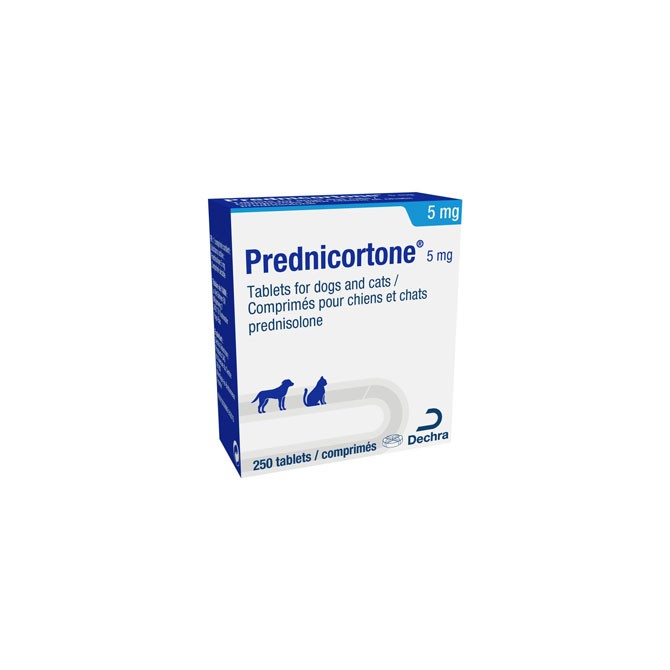
Prednicortone 5mg Tablet for Dogs and Cats - per Tablet
390847
5mg Prednicortone Tablets for Dogs and Cats are used for the symptomatic treatment or as adjunct treatment of inflammatory and immunemediated diseases in dogs and cats. VETERINARY PRESCRIPTION REQUIRED.
Product Features
- Pack Size: - Sold Individually
- Target Animal: - Dogs and Cats
- Pet Prescription Required?: - Yes
- Active Ingredient: - Prednisolone
- Product Name: - 5mg Prednicortone
More Information
Description
Prednicortone 5mg Tablets for Dogs and Cats - Per Tablet
This medication may only be supplied with a valid veterinary prescription issued by your vet. You should only purchase this item if you have or are in the process of arranging such a prescription. See information bar for further details.
Target species
Dogs and cats.
Indications for use, specifying the target species
Prednicortone is used for the symptomatic treatment or as adjunct treatment of inflammatory and immune-mediated diseases in dogs and cats.
Contraindications
Do not use Prednicortone in animals suffering from viral or mycotic infections.
Do not use in animals suffering from diabetes mellitus or hyperadrenocorticism. Do not use in animals with osteoporosis
Do not use in Prednicortone animals suffering from cardiac or renal dysfunction
Do not use in animals suffering from corneal ulcers.
Do not use in animals with gastro-intestinal ulceration.
Do not use in animals with burns.
Do not use concomitantly with attenuated alive vaccine
Do not use in the case of glaucoma.
Do not use during pregnancy (see section 4.7).
Do not use in known cases of hypersensitivity to the active substance, to corticosteroids or to any of the excipients.
Special warnings for each target species
Corticoid administration is to induce an improvement in clinical signs rather than a cure. The treatment should be combined with treatment of the underlying disease and/or environmental control.
Special precautions for use
Special precautions for use in animals
In cases where a bacterial infection is present the product should be used in association with suitable antibacterial therapy.
Because of the pharmacological properties of prednisolone, special care should be taken when the veterinary medicinal product is used in animals with a weakened immune system.
Corticoids such as prednisolone, exacerbate proteinaceous catabolism. Consequently, the product should be carefully administered in old or malnourished animals.
Corticoids such as prednisolone should be used with caution in patients with hypertension.
Pharmacologically-active dose levels of Prednicortone may lead to atrophy of the adrenal cortex, resulting in adrenal insufficiency. This may become apparent particularly after withdrawal of corticosteroid treatment. Adrenal insufficiency may be minimised by institution of alternate-day therapy if practical. The dosage should be reduced and withdrawn gradually to avoid precipitation of adrenal insufficiency.
Special precautions to be taken by the person administering the veterinary medicinal product to animals
In case of accidental ingestion, seek medical advice immediately and show the package leaflet or the label to the physician.
People with known hypersensitivity to prednisolone or other corticosteroids or any of the excipients should avoid contact with the veterinary medicinal product.
corticosteroids can cause foetal malformations; therefore it is recommended that pregnant women avoid contact with the veterinary medicinal product. Immediately wash hands thoroughly after handling the tablets.
Adverse reactions (frequency and seriousness)
Anti-inflammatory corticosteroids, such as Prednicortone, are known to exert a wide range of side effects. Whilst single high doses are generally well tolerated, they may induce severe side-effects in long term use. Dosage in medium to long term use should therefore generally be kept to the minimum necessary to control symptoms.
The significant dose related cortisol suppression noticed during therapy is a result of effective doses suppressing the hypothalamo-pituitreal adrenal axis. Following cessation of treatment, signs of adrenal insufficiency extending to adrenocortical atrophy can arise and this may render the animal unable to deal adequately with stressful situations. Consideration should therefore be given to means of minimising problems of adrenal insufficiency following the withdrawal of treatment.
The significant increase in triglycerids noticed can be a part of possible iatrogenic hyperadrenocorticism (Cushings disease) involving significant alteration of fat, carbohydrate, protein and mineral metabolism, e.g. redistribution of body fat, increase in body weight, muscle weakness and wastage and osteoporosis may result. Cortisol suppression and an increase in plasma tryglicerids is a very common side-effect of medication with corticoids (more than 1 in 10 animals).
The increase of alkaline phosphatase by glucocorticoids could be related to enlargement of the liver (hepatomegaly) with increased serum hepatic enzymes.
Other changes in blood biochemical and haematological parameters probably associated with the use of prednisolone were significant effects noticed on lactate dehydrogenase (decrease) and albumin (increase) and on eosinophils, lymphocytes (decrease) and segmented neutrophils (increase).
A decrease in aspartate transaminase is also noticed.
Systemically administered corticosteroids may cause polyuria, polydipsia and polyphagia, particularly during the early stages of therapy. Some corticosteroids may cause sodium and water retention and hypokalaemia in long term use. Systemic corticosteroids have caused deposition of calcium in the skin (calcinosis cutis).
Corticosteroid use may delay wound healing and the immunosuppressant actions may weaken resistance to or exacerbate existing infections. In the presence of viral infections, corticosteroids may worsen or hasten the progress of the disease.
Gastrointestinal ulceration has been reported in animals treated with corticosteroids and gastrointestinal ulceration may be exacerbated by steroids in animals given non-steroidal anti-inflammatory drugs and in animals with spinal cord trauma.
Other adverse reactions that may occur are: inhibition of longitudinal growth of bones; skin atrophy; diabetes mellitus; euphoria, pancreatitis, decrease in thyroid hormone synthesis; increase in parathyroid hormone synthesis. See also section 4.7.
Use during pregnancy and lactation
Do not use in pregnant animals. Studies in laboratory animals have shown that administration during early pregnancy may cause foetal abnormalities. Administration during the later stages of pregnancy may cause abortion or early parturition. See section 4.3.
Use during lactation only according to the benefit /risk assessment by the responsible veterinarian.
Interaction with other medicinal products and other forms of interaction
Phenytoin, barbiturates, ephedrine and rifampicin, may accelerate the metabolic clearance of corticosteroids resulting in decreased blood levels and reduced physiological effect.
The concomitant use of this veterinary medicinal product with non-steroidal anti-inflammatory drugs may exacerbate gastrointestinal tract ulceration. Because corticosteroids can reduce the immunoresponse to vaccination, prednisolone should not be used in combination with vaccines or within two weeks after vaccination.
Administration of prednisolone may induce hypokalaemia and hence increase the risk of toxicity from cardiac glycosides. The risk of hypokalaemia may be increased if prednisolone is administered together with potassium depleting diuretics.
Amounts to be administered and administration route
For oral administration.
The dose and total duration of treatment is determined by the veterinarian per individual case depending on the severity of symptoms. The lowest effective dose must be used.
Starting dose: 0.5 - 4 mg per kg bodyweight per day.
For longer term treatment: when after a period of daily dosing the desired effect has been achieved, the dose should be reduced until the lowest effective dose is reached. The reduction of the dose should be made by alternate day therapy and /or by halving the dose with intervals of 5-7 days until the lowest effective dose is reached.
Dogs should be treated in the morning and cats in the evening on account of differences in day rhythm.
Tablets can be divided into 2 or 4 equal parts to ensure accurate dosing. Place the tablet on a flat surface, with its scored side facing up and the convex (rounded) side facing the surface.
Halves: press down with your thumbs on both sides of the tablet.
Quarters: press down with your thumb in the middle of the tablet.
Overdose (symptoms, emergency procedures, antidotes), if necessary
An overdose does not cause other adverse effects than those stated in section 4.6. An antidote is not known
Withdrawal period(s)
Not applicable
PHARMACOLOGICAL PROPERTIES
Pharmacotherapeutic group: corticosteroid for systemic use, glucocorticoid.
ATCvet code: QH02AB06
Pharmacodynamic properties
Prednisolone is a semi-synthetic corticosteroid derived from the natural hydrocortisone (cortisol) . However, the effect on the mineral and glucose metabolism is less (about half ) than that of cortisol . This minimizes the unfavorable fluid retention and hypertension.
The effect of prednisolone is anti-inflammatory. When an inflammatory reaction is useful (for example to prevent further invasion of micro -organisms) suppression of this defense mechanism is counterproductive. However, when the inflammatory response is excessive and/or harmful (e.g. a response to an autoimmune or allergic process), the defensive inflammatory response worsens the situation and repression by corticosteroids may be of great therapeutic importance.
- By a protein catabolic effect the formation of granulation tissue is inhibited.
- Inhibition of the inflammation is also achieved by the stabilizing effect of prednisolone on the lysosomal membranes
- Corticosteroids reduce the development of inflammatory exudate and local oedema by stimulating vasoconstriction and by decreasing the capillary permeability.
- Anti-allergic effect and immunosuppression: these effects are partly related to the anti-inflammatory activity and are mainly directed against cellular (T - lymphocytes) immunoreactivity .
Because orally administered corticosteroids develop their therapeutic effect only after several hours, they are less suitable for the treatment of (acute) anaphylactic reactions such as septic shock.
Pharmacokinetic particulars
Following oral administration prednisolone is well absorbed from the gastrointestinal tract and distributes in all tissues, in the body fluids and even in the cerebrospinal fluid. Prednisolone is extensively bound to plasma proteins. It is metabolized in the liver and excretion takes place mainly via the kidneys.
PHARMACEUTICAL PARTICULARS
List of excipients
Yeast (dried)
Chicken flavourLactose monohydrate
Cellulose, powdered
Sodium starch glycolate (Type A)
Magnesium stearate
Incompatibilities
Not applicable
Shelf life
Shelf life of the veterinary medicinal product as packaged for sale: 3 years
Shelf life of the divided tablets: 4 days
Special precautions for storage
Any unsued tablet portion should be returned to the open blister.
This veterinary medicinal product does not require any special temperature storage conditions.
Nature and composition of immediate packaging
Aluminium - PVC/PE/PVDC blister
Cardboard box of 1, 2, 3, 4, 5, 6, 7, 8, 9, 10, 15, 25 or 50 blisters of 10 tablets
Not all pack sizes may be marketed.
Special precautions for the disposal of unused veterinary medicinal product or waste materials derived from the use of such products
Any unused veterinary medicinal product or waste materials derived from such veterinary medicinal products should be disposed of in accordance with local/national requirements.



